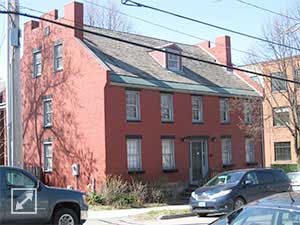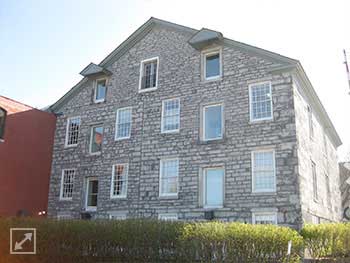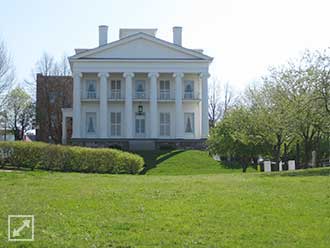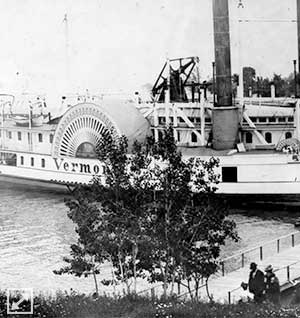Focal Places in Burlington
The Waterfront: Industrial History
Colonial Settlement
The Burlington waterfront was not the very first serious European settlement in the area, but the first permanent cluster of settlements. The first occurred in the fall of 1772 when Ira Allen, his brother Ethan, and a handful of others settled near the Winooski River falls on the north side of the river. Industry was a driving force of the Burlington waterfront from the very start. 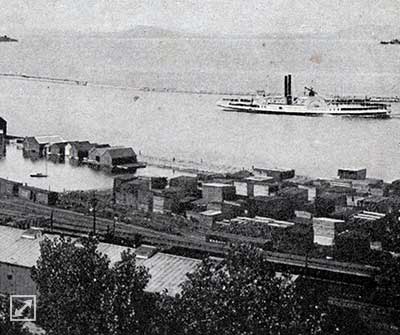
Burlington waterfront, mid-1800sIn Ira’s own words, his goal was “to look for the best place for trade, at or near Lake Champlain...which I faithfully attended to, and gave Burlington Bay the preference of any part of the country." He was confident that “Burlington would, from its situation, become a place of consequence."
At the same time, in 1773, another man named Felix Powell, made a settlement at Appletree Point. But, by 1776, the harsh frontier life, presence of Native Americans, and the turmoil of the Revolutionary War drove the settlers away for the time being. After the war in 1783, the settlers came back to stay.
By 1792 there were a few buildings in present day Burlington. They were located near the lake shore in the oldest part of the city, on what was called Water Street, but is now called Battery Street. It was called Water Street because the lakeshore came right up to the edge of the street, hundreds of feet from where it is now. Most of 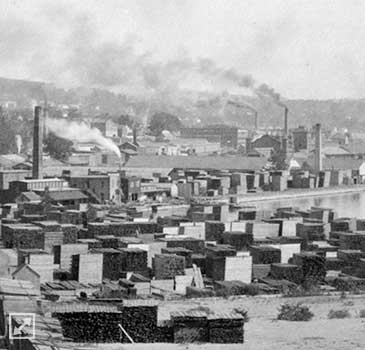
Burlington waterfront, 1870the shore was a steep bank, so the first settlements were around the Maple and King Street blocks where the land flattened out and access to the water was easier.
Back then, Maple and King Street had different names. The earliest map located for this project by Ammi Young shows that in 1830, lower Maple Street was called wharf street, King Street was called Pine Street, and Main Street was known as Fayette St. By mid-century, Main Street and King Street had taken up their contemporary names, but Maple Street was known as South Street.
The area was one of the only areas without forests before 1800. This early settlement of Burlington was cradled by a natural ravine that curved southward from what is now Prospect Street to what is now lower King Street. Present day Maple Street wouldn’t be able to exist in its entirety if the ravine still carved through the city today because it cuts the street in half. You can still notice the natural ravine between South Winooski Street and Church Street behind the Burlington Telecom building. In the mid-1800’s map of Burlington below you can see where the old ravine once was because the train tracks circling into town followed the same route. The oldest part of the town is in the southwest quadrant, between the ravine and the water.
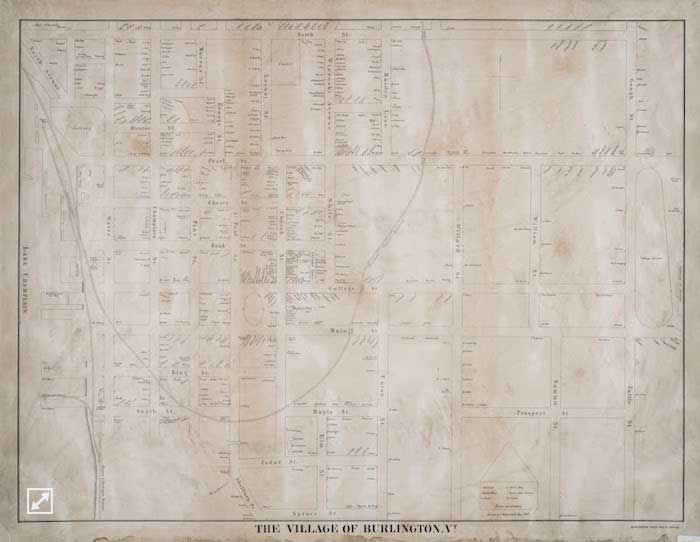
Trade Along the Waterfront
One of the early inhabitants of Water Street was William Hickok. He ran a store in a small wooden structure on the bank of the lake. It is where the “lake house” is now. Goods were shipped to Burlington to some of the earliest inhabitants. They came in scows from Whitehall, New York. Some goods like molasses and liquor were thrown over board from the scows and allowed to float to shore because there was no wharf or dock until the turn of the century. The shipment of lumber became an industry from the very start of commercialism along the waterfront. Other early trade included the gathering and shipping of pot and pearl ashes which were used to bleach textiles or make glass and soap. The ashes were profitable byproducts from the clearing of forest land to make way for agriculture. At this time, land was quickly being cleared in Vermont, so the ashes were a perfect complimentary commodity of lumber. Another early industry was wheat grown inland in Vermont that was then shipped to Troy, New York.
After he died, William’s son Samuel took over the store. When the business started to thrive, he opened a second store on Main Street. This three-story brick building at Courthouse Square, currently known as City Hall Park, was one of the first brick buildings in Burlington, and may have helped establish that area of the city as a center for activity.
Meanwhile, back at the lake front, the shipping industry was picking up. By the turn of the century, ship-building had become a profitable industry and commodities were being shipped by local merchants to places in faraway ports. In turn, the town began to grow out from its waterfront edge.
Around 1800, the early village of Burlington bay had a handful of innkeepers and retail merchants, a couple ship-buildings, a silversmith, a blacksmith, and a few other specialty workshops.Prominent businessmen began to rise from the newly created wealth. One of these men was Gideon King Jr., also known as “The Admiral of Lake Champlain." He was the son of tavern owner Gideon King Sr. Gideon King Jr. started in the shipping business in Burlington at age 16. His early years were in fur trading, working for John Jacob Astor of New York. But, it wasn’t long before he had his hands in most aspects of the early Burlington shipping industry. He controlled almost half of the early commercial sailing ships on the lake from 1800-1826. His powerful shipping fleet proved invaluable during the War of 1812 as it kept the town supplied of its basic needs while tensions on the lake made shipping difficult. His house still stands on King Street in Burlington’s old harbor section.
Built in 1798, it is arguably the first brick building in the city. The city’s street plan was approved here at a meeting.Another important figure was Timothy Follet. He was a state’s attorney and a county judge at a very young age (24). But, when the Champlain Canal opened in 1823, Follet saw an opportunity to dive into the mercantile business. He resigned as judge, and joined schooner and steamboat captain, Henry Mayo in a business venture. They controlled the South Wharf and a fleet of canal boats. In 1827, they built the Old Stone Store, which is still standing at the corner of Maple and Battery Street. The structure was built with Isle la Motte limestone.
At the time the store was built, the waterfront went up nearly to its edge. It was perfect
for unloading goods. Many of the commodities that arrived in early Burlington went through the store.In 1841, Follet built the iconic white house that still stands on lower College Street to celebrate the wealth he had gained. This building is also one of the oldest remnants of Burlington’s past. It is currently used by Pomerleau Real Estate.
It was odd for a wealthy businessman to build his mansion so close to the waterfront during that time period. Most of the merchants and lumber barons of early Burlington built their mansions further up the hill on South Union Street and in the steeper part of the city, where they could avoid the loud noises and the smell of the lumbering activity. People speculate that Follet either craved a close waterfront view or he wanted to watch over his businesses. Unfortunately for him, after buying one of the major railroads, he drove the company into bankruptcy.
The early 1800’s trade sent cattle, cheese, butter fish, flax, furs, grain, maple sugar, potash, pearl ash, sheep, and tobacco to Canada. In return, Canada was shipping gin, rum, salt, and luxury items from Europe like chocolate, coffee, tea, and textiles to Burlington. During the warm months ships or log rafts carried the goods. When the ice was frozen, horse-drawn sleighs did the job.
But, it wasn’t long before a bigger, more reliable form of water transportation was developed. In front of the present day “Ice House,” the world’s second steamboat, named Vermont was built in 1808 by John and James Winans. But in 1809, in good old Vermont fashion, the boat got stuck in the mud when they were attempting to launch it because the engine was so heavy. They had to get a lumber sleigh to come to the harbor and help get the steamship hoisted up onto logs so it could be rolled all the way into the lake.
The historic ice house building was built in 1809 as John Winan’s home. But, the property served multiple uses until its present day function as a restaurant. The original structure burnt down in 1868. But, a new house was built on its original red rock foundation, and would become the location of the Consumers Ice Company. They used this building to store ice that they harvested from the lake in the winter months, and sold to citizens to use for refrigeration. The walls of the building are extra thick with 19th century insulation so that the ice could last through the summer. By the 1890s, the company was cutting about 60,000 tons of ice from a half mile in front of the Burlington breakwater with an army of 60 men and 20 teams of horses. A tunnel was dug from the water to their warehouse, where the ice could be more easily transported from the lake with some kind of conveyor system.
The early shipping years of the Burlington waterfront were not always easy. In 1807, President Thomas Jefferson started an embargo on trade with Britain and Canada because of the mounting tension with the British leading up to the War of 1812. This was an enormous blow to the Burlington merchants as Canada was the biggest trade partner. But, many merchants were not willing to give up their profits, so they decided to smuggle goods into the harbor. U.S. customs agents were stationed on the lake and kept a close watch on the activity. One day in August of 1808, a U.S. customs ship called Fly got into a skirmish with a smuggler ship known as the Black Snake on the Winooski River. Three U.S. officials were shot and killed. Some of the crew of the Black Snake were sent to prison, while one of them was executed by a public hanging in Burlington in front of a crowd of 10,000 people.
Once the war broke out, goods continued to be smuggled in and out of Burlington harbor and unfortunately for the U.S. effort, some of these goods kept the British effort supplied. The United States stationed 4,000 soldiers at Battery Park. At the time, this was more than twice the population of the town of Burlington. Canons were placed on the bluff to protect the town and especially its fleet of ships. Burlington harbor was only attacked once when the British fired canons at Battery Park.
After the war, the quaint town of Burlington nestled along the harbor was about to go through some big changes, changes that would alter the natural harbor in significant ways that are still an important part of the waterfront we know today.
